Scientists are beginning to explore joy in the animal world
Jonathan Balcombe
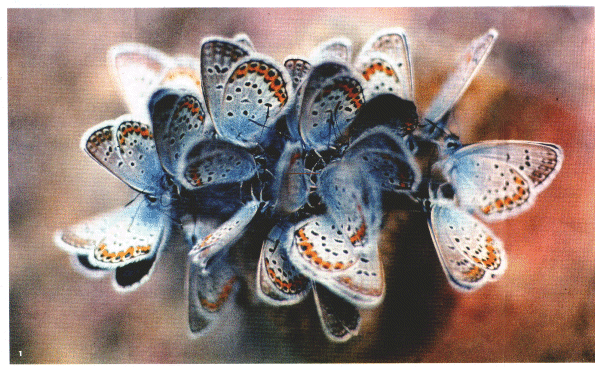
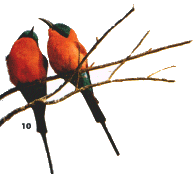
In a freshwater spring in Kenya, hippopotami drift blissfully splaying their
toes, spreading their legs, and opening their mouths as fishes of various
species provide a spa treatment by nibbling away bits of food, sloughing
skin and parasites...
Chances are that you've wimessed expressions of animal pleasure. If you've
lived with dogs or cats you may have noticed how most of them enjoy being
stroked, scratched, or rubbed. Indeed, that we refer to them as pets attests
to their love of touch is well as our pleasure in touching them.
One of our cats, Megan, adores a belly rub, which she solicits by making
a distinctive chirruping sound and flopping onto her side or back. It's a
cat billboard that says: "Here is my belly. Please start rubbing." How can
one resist an invitation like that? As I rub, she stretches out to her full
length, flopping from one side to the other and purring loudly. If I pick
up the cat brush and thump it on the floor, Megan doesn't just walk over,
she comes running.
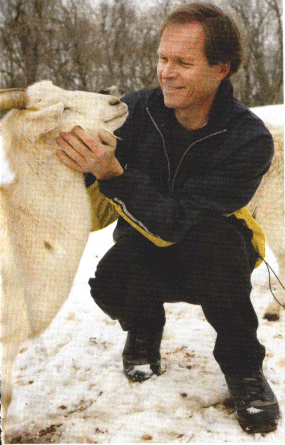
As yet, there are few scientific studies on animal pleasure. Some of these,
however, are very good and today, evidence is rapidly accumulating that life
for animals holds great potential for joy. I argue throughout my new book,
The Exultant Ark: a Pictorial Tour of Animal Pleasure, that pleasure
is central to animal existence. Believe it or not, this is a controversial
claim. There has been very little discussion of animal pleasure by biologists.
Indeed, there is littie serious discussion of pleasure in hutnans, let alone
nonhumans. Curiously, animals' capacity for pain - while no less physically
private than their capacity for pleasure - has been extensively studied and
is uncontroversial.
Why do we shun pleasure? Part of the reason is that science, by and large,
has held and continues to hold a narrow perspective in its scholarly
interpretation of animal existence. Published studies of animal behaviour
are presented almost exclusively in an ulitimate, evolutionary context, without
discussion of the animals' more immediate mental and emotional experiences.
Scientists who study positive experiences in animals are still few and far
between, but one of them is the physiologist Michel Cabanac, at Laval University
in Quebec. Cabanac coined the term alliesthesia (from the Greek for
"other-perception") to describe the phenomenon whereby an identical stimulus
may be perceived as pleasant or unpleasant depending on the physiological
state of the subject.
For example, when Cabanac had people dip their hand in a container of cold
water, they reported the experience as pleasant if they were feeling hot
and unpleasant if they were feeling cold. Animals too show
alliesthesia, which also applies to tastes (pleasant when hungry,
unpleasant when full).
As Darwin showed, we humans are just one of many wonderful and unique expressions
of nature: our differences from other mammals (at least) are in degree, not
kind. Crucially, when it comes to sentience, humans may not always be the
most endowed.
Some scientists, such as neuroscientists Jeffrey Burgdorf and Jaak Panksepp,
believe that other lifeforms may experience certain feelings more intensely
than humans do.
When my cat Megan receives her belly rubs, she seems totally absorbed in the moment - enwrapped in a pleasure whose pureness may be more difficult to attain for us whose minds become easily preoccupied with our thoughts. We already know that many animals have keener senses than our own. Owls have better night vision and hearing, sharks have stronger chemical perception, and dogs have a better sense of smell. In some cases, animals experience physical sensations that are unknown to us. What might it feel like to orient in flight or to identify different types of insect by listening to one's echoes, as bats do? Or to communicate by means of vibrations, as many burrowing animals do, or to sense the earth's magnetic field?
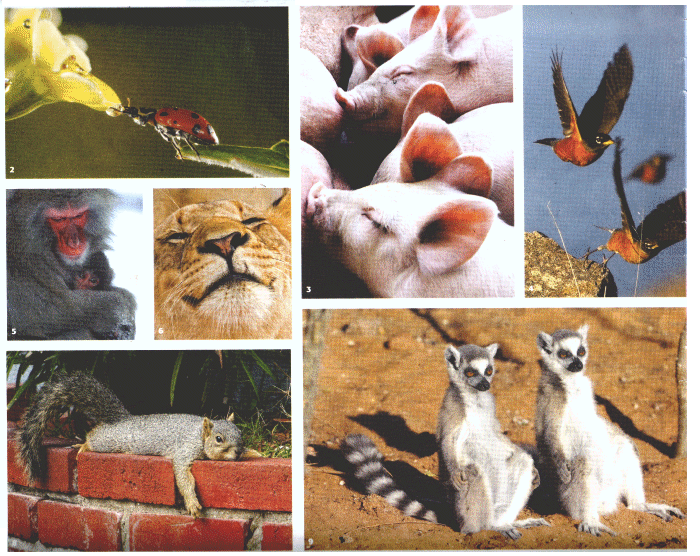
Not just a struggle for survival
Advances in our knowledge and understanding of animal sentience are compelling
us to reconsider our prejudice toward animals. One such prejudice is the
notion that life in the wild is a relentiess, earnest struggle. Popular phrases
such as "nature red in tooth and claw," "eat or be eaten," and "the struggle
for survival" reinforce the impression that life for wild creatures is harsh
and grim. This is a biased and inaccurate perspective.
Consider that survival behaviours in themselves can be rewarding: just becaus
reindeer have to migrate 1,000 miles to flind seasonably available food,
or prairie dogs need to dig burrows to avoid predation, doesn't mean they
can't take pleasure in these tasks. Goal-directed activities, such as important
survival behaviours, are desirable for animals, who need to exert some control
over their
lives.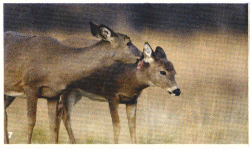
Finding food is one of the major projects of an animal's life, and many with
the misfortune of being confined have been shown to engage in what is called
'contrafreeloading' - given the opportunity caged rats will pull a lever
to obtain food that is otherwise freely available without having to engage
in these activities. Take away life's significance, and you may be taking
away a lot of what pleasure derives from.
Also, animals do in fact have leisure time. Many animals meet their survival
needs in a fraction of the time available to them. The primatologist Robert
Sapolsky estimates that savannah baboons on the Serengeti plains of Kenya
take about four hours to feed themselves in a given day. Flight affords many
birds the luxury of meeting their energy needs in a fraction of their waking
time. Animals may spend part of the remaining time engaged in such activities
as grooming and preening, playing, singing (birds), or resting.
Another common prejudice is that animals raised for food are less worthy
of our consideration than wild animals. Pigs are often perceived as filthy,
chickens as cowardly and stupid, and sheep as passive followers. In fact,
farmed animals have been well studied, and none of the biases we hold against
them stand up to scrutiny. Chickens, for example, have a vocabulary of at
least thirty different
call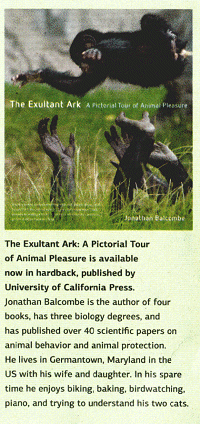 s.
Some are referential, meaning that the signaller is referring to a specific
object in the environment. Studies by Chris Evans and his colleagues at Macquarie
University in Australia, show that a chicken on the receiving end of these
calls understands their meaning. Studies at Cambridge University show that
a sheep can remember the faces of fifty of her original flock-mates from
single photographs, two years after she was moved into a different flock.
Sheep also read emotions on the faces of other sheep: they prefer to access
food through a door with a photo of a just-fed (contented) sheep than a door
with a hungry (stressed) sheep.
s.
Some are referential, meaning that the signaller is referring to a specific
object in the environment. Studies by Chris Evans and his colleagues at Macquarie
University in Australia, show that a chicken on the receiving end of these
calls understands their meaning. Studies at Cambridge University show that
a sheep can remember the faces of fifty of her original flock-mates from
single photographs, two years after she was moved into a different flock.
Sheep also read emotions on the faces of other sheep: they prefer to access
food through a door with a photo of a just-fed (contented) sheep than a door
with a hungry (stressed) sheep.
Animals have experiences
The real world runs on experience. For instance, when adding spices to our
food I'm not aware that anyone reaches for the oregano or the curry powder
with the conscious intent of warding off intestinal microbes. We spice our
food because it enhances the taste. Similarly, animals are not mechanical
slaves to evolutionary adaptations; they too have experiences.
Happy, healthy animals are beautiful to behold. They make us smile, and there's
value in that. But pleasure has deeper meaning and significant implications
for humankind's relationship with other animals. Pleasure adds intrinsic
value to life - that is, value to the individual who feels it regardless
of any perceived worth to anyone else. Pleasure seekers have wants, needs,
desires, and lives worth living. They can have a good quality of life. If
we let them.
As you look at the pictures on these pages enjoy the pleasure they bring
you. Bathe in their beauty and soak in their grace. Reflect on the significance
of the fact that animals also experience good feelings. And the next time
you see a crow or a cat or a lizard, stop and watch. Try to imagine their
experience.
MORE INFORMATION:
www.jonathanbalcombe.com
www.ucpress.edu
IMAGES:
- 1. Butterflies known as 'blues' are drawn to nutrients in a lump of ferret dung. Photo: © Dennis Lorenz
- 2. Ladybird Beetle. Photo: © Scott Linstead
- 3. These pigs were rescued by Farm Sanctuary in New York, an organisation that cares for neglected animals. Photo: © Siobhan McClory
- 4. American Hawk Robin, Mount Tamaiplais. California. Photo: © Trish Carney
- 5.JapaneseMacaque,Detroit zoo. Recent studies with baboons show that the loss of an infant triggers the same hormonal changes In the mother that have been documented in women grieving the loss of a child. Photo: © Robert Parnell
- 6. African Lion, South Africa. Like their domestic cousins, lions are masters at stretching. The lioness's expression captures the distinctive pleasure of this activity. Photo: © Mike Moss
- 7. White-Tailed Deer. Photo: © Vic Harris
- 8. Western Grey Squirrel. Many mammals and reptiles use the heat absorbed by rocks - or bricks - to warm up. Photo: © Mike Moss
- 9. Ring-tailed Lemur. Madagascar. The sun is the energy foundation for nearly all life on Earth. And, as any sunbather knows, it feels good. Photo: © Steve Mandel
- 10. Carmine Bee-Eater, Botswana.Family members often perch together. Photo: © Robert Ganz